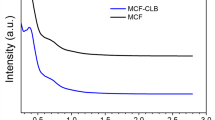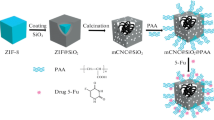Abstract
Purpose
A novel mesocellular carbon foam (MSU-FC) with a large pore size and a three-dimensional porous structure for the oral delivery of poorly water-soluble drugs was prepared. The goal of this study was to improve in vitro dissolution and in vivo absorption of celecoxib (CEB), a model drug, by means of novel carbon-based nanoparticles prepared from the MSU-FC matrix.
Methods
The MSU-FC matrix was synthesized by an inverse replica templating method using mesocellular silica template. A solvent immersion/evaporation method was used to load the drug molecules. The drug-loaded nanoparticles were characterized for morphology, surface area, particle size, mesoporous structure, crystallinity, solubility and dissolution. The effect of MSU-FC on cell viability was measured using the MTT conversion assay. Furthermore, the oral bioavailability of CEB-loaded MSU-FC in fasted rats was compared with that of the marketed product.
Results
Our results demonstrate that CEB incorporation into the prepared MSU-FC resulted in an approximately 9-fold increase in aqueous solubility in comparison with crystalline CEB. MSU-FC produced accelerated immediate release of CEB in comparison with crystalline CEB (pure CEB powder or marketed formulation) and the drug-loaded conventional mesoporous carbon particles. The relative bioavailability of CEB for CEB-loaded MSU-FC was 172%. In addition, MSU-FC nanoparticles exhibited very low toxicity.
Conclusions
The MSU-FC nanomatrix has been shown to be a promising drug delivery vehicle for improving the dissolution and biopharmaceutical characteristics of poorly water-soluble drugs.










Similar content being viewed by others
References
Hörter D, Dressman JB. Influence of physicochemical properties on dissolution of drugs in the gastrointestinal tract. Adv Drug Deliv Rev. 2001;46(1–3):75–87.
Lipinski CA, Lombardo F, Dominy BW, Feeney PJ. Experimental and computational approaches to estimate solubility and permeability in drug discovery and development setting. Adv Drug Deliv Rev. 1997;23(1–3):3–25.
Kawabata Y, Wada K, Nakatani M, Yamada S, Onoue S. Formulation design for poorly water-soluble drugs based on biopharmaceutics classification system: basic approaches and practical applications. Int J Pharm. 2001;420(1):1–10.
Lukyanov AN, Torchilin VP. Micelles from lipid derivatives of water-soluble polymers as delivery systems for poorly soluble drugs. Adv Drug Deliv Rev. 2004;56(9):1273–89.
Huanga LF, Tong WQT. Impact of solid state properties on developability assessment of drug candidates. Adv Drug Del Rev. 2004;56(3):321–34.
Kipp JE. The role of solid nanoparticle technology in the parenteral delivery of poorly water-soluble drugs. Int J Pharm. 2004;284(1–2):109–22.
Chen H, Khemtong C, Yang X, Chang X, Gao J. Nanonization strategies for poorly water-soluble drugs. Drug Discov Today. 2011;16(7–8):354–60.
Vasconcelos T, Sarmento B, Costa P. Solid dispersions as strategy to improve oral bioavailability of poor water soluble drugs. Drug Discov Today. 2007;12(23–24):1068–75.
LaVan DA, McGuire T, Langer R. Small-scale systems for in vivo drug delivery. Nat Biotechnol. 2003;21:1184–91.
Merisko-Liversidge E, Liversidge GG. Nanosizing for oral and parenteral drug delivery: a perspective on formulating poorly-water soluble compounds using wet media milling technology. Adv Drug Deliv Rev. 2011;63(6):427–40.
Eerdenbrugh BV, Mooter GV, Augustijns P. Top-down production of drug nanocrystals: nanosuspension stabilization, miniaturization and transformation into solid products. Int J Pharm. 2008;364(1):64–75.
Ghosh I, Bose S, Vippagunta R, Harmon F. Nanosuspension for improving the bioavailability of a poorly soluble drug and screening of stabilizing agents to inhibit crystal growth. Int J Pharm. 2011;409(1–2):260–8.
Constantinides PP, Chaubal MV, Shorr R. Advances in lipid nanodispersions for parenteral drug delivery and targeting. Adv Drug Del Rev. 2008;60(6):757–67.
Kesisoglou F, Panmai S, Wu Y. Nanosizing–Oral formulation development and biopharmaceutical evaluation. Adv Drug Del Rev. 2007;59(7):631–44.
Alexis F, Pridgen E, Molnar LK, Farokhzad OC. Factors affecting the clearance and biodistribution of polymeric nanoparticles. Mol Pharm. 2008;5(4):505–15.
Barbé C, Bartlett J, Kong L, Finnie K, Lin HQ, Larkin M, et al. Silica particles: a novel drug-delivery system. Adv Mater. 2004;16(21):1949–66.
Jaganathan H, Godin B. Biocompatibility assessment of Si-based nano- and micro-particles. Adv Drug Deliv Rev. 2012;64(15):1800–19.
Trewyn BG, Slowing II, Giri S, Chen HT, Lin VSY. Synthesis and functionalization of a mesoporous silica nanoparticle based on the sol–gel process and applications in controlled release. Acc Chem Res. 2007;40(9):846–53.
Yang F, Gai S, Lin J. Functionalized mesoporous silica materials for controlled drug delivery. Chem Soc Rev. 2012;41(9):3679–98.
Zhang Y, Wang J, Bai X, Jiang T, Zhang Q, Wang S. Mesoporous silica nanoparticles for increasing the oral bioavailability and permeation of poorly water soluble drugs. Mol Pharm. 2012;9(3):505–13.
Thomas MJK, Slipper I, Walunj A, Jain A, Favretto ME, Kallinteri P, et al. Inclusion of poorly soluble drugs in highly ordered mesoporous silica nanoparticles. Int J Pharm. 2009;387(1–2):272–7.
Zhang Y, Zhi Z, Jiang T, Zhang J, Wang Z, Wang S. Spherical mesoporous silica nanoparticles for loading and release of the poorly water-soluble drug telmisartan. J Control Release. 2010;145(3):257–63.
Li Z, Barnes JC, Bosoy A, Stoddart JF, Zink JI. Mesoporous silica nanoparticles in biomedical applications. Chem Soc Rev. 2012;41(7):2590–605.
Wani A, Muthuswamy E, Savithra GHL, Mao G, Brock S, Oupický D. Surface functionalization of mesoporous silica nanoparticles controls loading and release behavior of mitoxantrone. Pharm Res. 2012;29(9):2407–18.
Vignolini S, Yufa NA, Cunha PS, Guldin S, Rushkin I, Stefik M, et al. A 3D optical metamaterial made by self-assembly. Adv Mater. 2012;24(10):23–7.
Ji X, Lee KT, Nazar LF. A highly ordered nanostructured carbon–sulphur cathode for lithium-sulphur batteries. Nat Mater. 2009;8:500–6.
Liang C, Li Z, Dai S. Mesoporous carbon materials: synthesis and modification. Angew Chem. 2008;47(20):3696–717.
Wang X, Liu P, Tian Y. Ordered mesoporous carbons for ibuprofen drug loading and release behavior. Micropor Mesopor Mater. 2011;142(1):366–85.
Zhao P, Wang L, Sun C, Jiang T, Zhang J, Zhang Q, et al. Uniform mesoporous carbon as a carrier for poorly water soluble drug and its cytotoxicity study. Eur J Pharm Biopharm. 2012;80(3):535–43.
Heikkilä T, Salonen J, Tuura J, Hamdy MS, Mul G, Kumar N, et al. Mesoporous silica material TUD-1 as a drug delivery system. Int J Pharm. 2007;331(1):133–8.
Rosenholm JM, Lindén M. Towards establishing structure-activity relationships for mesoporous silica. J Control Release. 2008;128(2):157–64.
Wang S. Ordered mesoporous materials for drug delivery. Micropor Mesopor Mater. 2009;117(1–2):1–9.
Vallet-Regí M, Balas F, Arcos D. Mesoporous materials for drug delivery. Angew Chem Int Edit. 2007;46(40):7548–58.
Tatsuda N, Yano K. Pore size control of monodispersed starburst carbon spheres. Carbon. 2013;51:27–35.
An S, Park JH, Shin CH, Joo J, Ramasamy E, Hwang J, et al. Well-dispersed Pd3Pt1 alloy nanoparticles in large pore size mesocellular carbon foam for improved methanol-tolerant oxygen reduction reaction. Carbon. 2011;49(4):1108–17.
Kwak G, Hwang J, Cheon JY, Woo MH, Jun KW, Lee J, et al. Preparation method of Co3O4 nanoparticles using ordered mesoporous carbons as a template and their application for fischer-tropsch synthesis. J Phys Chem C. 2013;117(4):1773–9.
Dolenc A, Kristl J, Baumgartner S, Planinšek O. Advantages of celecoxib nanosuspension formulation and transformation into tablets. Int J Pharm. 2009;376(1–2):204–12.
Paulson SK, Vaughn MB, Jessen SM, Lawal Y, Gresk CJ, Yan B, et al. Pharmacokinetics of celecoxib after oral administration in dogs and humans: effect of food and site of absorption. J Pharmacol Exp Ther. 2001;297(2):638–45.
Zhang Y, Zhang J, Jiang T, Wang S. Inclusion of the poorly water-soluble drug simvastatin in mesocellular foam nanoparticles: Drug loading and release properties. Int J Pharm. 2011;410(1–2):118–24.
Yan X, He P, Xia Y. Preparation of mesocellular carbon foam and its application for lithium/oxygen battery. Electrochem Commun. 2009;11(6):1127–30.
Yu L. Amorphous pharmaceutical solids: preparation, characterization and stabilization. Adv Drug Deliv Rev. 2001;48(1):27–42.
Skinner LM, Sambles JR. The Kelvin equation—a review. J Aerosol Sci. 1972;3(3):199–210.
Noyes AS, Whitney WR. The rate of solution of solid substances in their own solutions. J Am Chem Soc. 1897;19(12):930–4.
Horcajada P, Rámila A, Pérez-Pariente J, Vallet-Regi M. Influence of pore size of MCM-41 matrices on drug delivery rate. Micropor Mesopor Mater. 2004;68(1–3):105–9.
Cauda V, Muhlstein L, Onida B, Bein T. Tuning drug uptake and release rates through different morphologies and pore diameters of confined mesoporous silica. Micropor Mesopor Mater. 2009;118(1–3):435–43.
Acknowledgments and disclosures
This work was generously supported by the National Basic Research Program of China (973 Program) (No.2009CB930300). Dr. David B. Jack is gratefully thanked for correcting English of the manuscript.
Author information
Authors and Affiliations
Corresponding author
Rights and permissions
About this article
Cite this article
Zhang, Y., Wang, H., Li, C. et al. A Novel Three-Dimensional Large-Pore Mesoporous Carbon Matrix as a Potential Nanovehicle for the Fast Release of the Poorly Water-soluble Drug, Celecoxib. Pharm Res 31, 1059–1070 (2014). https://doi.org/10.1007/s11095-013-1227-9
Received:
Accepted:
Published:
Issue Date:
DOI: https://doi.org/10.1007/s11095-013-1227-9




